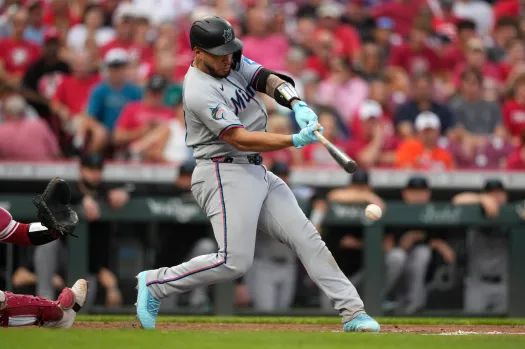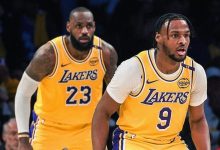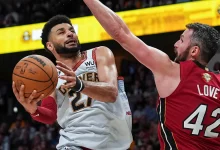Miami Heat memorabilia worth millions, including Finals jerseys, was stolen over 18 months and sold on legit and black markets, sparking suspicion of an inside job involving a Miami officer and NBA-linked person.

In the world of sports memorabilia, few stories have captured attention quite like the recent scandal involving the Miami Heat. Over an 18-month period, a significant collection of priceless memorabilia—most notably, game-worn NBA Finals jerseys—was stolen from the team’s vault. Valued at millions of dollars, these artifacts not only represent the pride and history of the franchise but also serve as coveted items for collectors worldwide. The theft, which involved both legitimate and black market sales, has raised serious suspicions of an inside job, allegedly involving a Miami police officer and an individual linked to the NBA. Now, a federal investigation is underway, aiming to uncover the full scope of the conspiracy and bring those responsible to justice.
This article delves into the details of the theft, the evidence pointing toward insider involvement, the ongoing investigation, and the broader implications for sports security and memorabilia integrity.
Background: The Significance of Miami Heat Memorabilia
The Miami Heat, established in 1988, quickly established itself as a formidable franchise, with multiple NBA Finals appearances and championships, notably in 2006, 2012, and 2013. The team’s history has been punctuated by iconic moments—LeBron James’s clutch performances, Dwyane Wade’s leadership, and key championship wins—all of which are immortalized in game-worn jerseys, rings, and other memorabilia.
These items are incredibly valuable, both monetarily and sentimentally. Authentic, game-worn NBA Finals jerseys, especially from championship-winning seasons, are among the most sought-after collectibles in sports history. Their rarity and significance make them prime targets for theft and illicit trade.
The Miami Heat’s vault, a secure storage facility maintained by the team, was believed to house such artifacts. However, recent events suggest that some of this priceless collection was compromised, leading to a scandal that has rocked the sports world.
The Timeline of the Theft
The 18-Month Window
Sources indicate that the theft occurred gradually over a period of approximately a year and a half. During this time, multiple high-value items, including jerseys worn during NBA Finals games, championship rings, and other rare artifacts, disappeared from the team’s secure vault.
Initial Warning Signs
The first signs of trouble surfaced when team officials noticed discrepancies in their inventory. Some items listed in the vault’s catalog were missing, yet routine security checks showed no signs of forced entry. This suggested that the theft may have involved insider access or internal complicity.
Emergence of Stolen Items on the Market
As months passed, stolen memorabilia began appearing on both legitimate and black markets. Several jerseys, authenticated and bearing official NBA tags, surfaced for sale online and through private collectors. Some of these items were sold at prices significantly above market value, raising suspicions about their provenance.
The Role of Online Marketplaces
The proliferation of online platforms—auction sites, private sales, and social media—facilitated the illegal trade. Some items appeared to have legitimate certificates of authenticity, but experts questioned their validity, suspecting counterfeits or stolen property being laundered through seemingly reputable channels.
Suspicion of Inside Involvement
Key Figures in Question
Law enforcement and industry insiders have zeroed in on potential inside actors. Among those under scrutiny are:
- A Miami police officer with access to the team’s vault and security protocols
- An individual linked to the NBA, possibly involved in the illicit sale or laundering of stolen artifacts
Why the Inside Job Theory?
Several factors support this suspicion:
- Access and Opportunity: The vault was reportedly well-secured, but insiders with authorized access could have exploited vulnerabilities. The fact that items went missing over an extended period suggests a systematic operation rather than opportunistic theft.
- Knowledge of Security Protocols: The insider, allegedly the Miami officer, would have detailed knowledge of security systems, making it easier to bypass alarms or surveillance.
- Sale of Items on Both Legitimate and Black Markets: The dual nature of the sales indicates a sophisticated operation that could only be coordinated by someone with inside knowledge of the memorabilia’s whereabouts and authentication processes.
- Previous Allegations or Rumors: There have been longstanding rumors within the sports memorabilia community about insider complicity in thefts, but no concrete proof until now.
The NBA-Linked Individual
The involvement of an NBA-linked person suggests the possibility of a network that facilitates the laundering of stolen items, converting them into legitimate assets through trusted channels, and then reselling them to collectors or auction houses.
The Federal Investigation
Why Federal Authorities Are Involved
Given the scale of the theft, the high value of the stolen artifacts, and the suspected insider involvement, federal law enforcement agencies, including the FBI, have taken charge. Federal jurisdiction is appropriate due to:
- Interstate commerce involved in the sale of stolen memorabilia
- The involvement of a law enforcement officer and potential organized crime
- The cross-state and possibly international nature of the illicit trade
Steps in the Investigation
The investigation is comprehensive and multifaceted:
- Secure and Catalog Recovered Items: Law enforcement has recovered hundreds of stolen artifacts, which are being examined for authenticity and provenance.
- Review Security Footage and Access Logs: Authorities are scrutinizing security footage, access logs, and personnel records to identify anomalies and potential insider access.
- Interviews and Surveillance: Investigators are interviewing team staff, security personnel, and the implicated officer, alongside monitoring online marketplaces.
- Undercover Operations: Federal agents are likely conducting undercover operations to identify and apprehend those involved in the black market sales.
- Financial Forensics: Tracing financial transactions related to the sale of stolen memorabilia to identify the buyers and laundering schemes.
Potential Charges
Those implicated could face charges including theft, conspiracy, wire fraud, and trafficking in stolen property. The case could also involve additional charges if organized crime is involved.
Broader Implications
For the Sports Memorabilia Industry
This case underscores vulnerabilities in the security of valuable artifacts. It highlights the need for:
- Improved physical security in storage facilities
- Rigorous authentication and provenance verification
- Enhanced monitoring of online sales channels
- Industry-wide cooperation to prevent theft and laundering
For Law Enforcement and Sports Organizations
The case underscores the importance of collaboration between law enforcement, sports leagues, teams, and collectors. It also raises questions about internal security protocols and the need for transparency and accountability.
Legal and Ethical Considerations
The scandal prompts a reevaluation of the legal framework surrounding sports memorabilia, especially regarding authentication, storage, and sale. It also calls for ethical standards to prevent insider abuse and fraud.
Lessons Learned and Future Safeguards
- Enhanced Security Measures: Teams must upgrade their security infrastructure, including biometric access controls, surveillance, and regular audits.
- Strict Authentication Protocols: Using blockchain or advanced forensic techniques can help establish tamper-proof provenance.
- Whistleblower Protections: Encouraging internal reporting can help detect insider threats early.
- Industry Collaboration: Establishing shared databases of stolen items and suspicious transactions can prevent stolen memorabilia from circulating freely.
- Public Awareness: Educating collectors about verifying authenticity and provenance can reduce the market for stolen items.
The Miami Heat memorabilia theft case is a stark reminder of the vulnerabilities in safeguarding sports history and assets. The involvement of an insider—possibly a Miami police officer—and an NBA-linked individual points to a sophisticated, organized effort that exploited internal access and external markets. As the federal investigation progresses, it is hoped that justice will be served, stolen items recovered, and systemic safeguards put in place to prevent similar incidents in the future.
This scandal not only tarnishes the legacy of the Miami Heat but also serves as a wake-up call for the entire sports industry. Protecting the integrity of sports memorabilia requires vigilance, technological innovation, and cross-sector cooperation. Only through concerted effort can the cherished artifacts of sports history remain safe and accessible to fans and collectors worldwide.









